Editor’s Note: Graduate Fellow Veronica Muskheli will be presenting her work on S. An-sky on Friday, April 19th, at the Spring Research Symposium sponsored by the Stroum Jewish Studies Program. Click here to view the full symposium schedule.
It is often confusing for people in America when I say that ethnically I am half-Jewish, because for most of them being Jewish means to practice the religion of Judaism. Ethnicity does not come into their understanding of the term. For Russia, where I am from, it is a perfectly reasonable statement: there, being Jewish first and foremost means to belong to an ethnic minority, to belong to people who actually sometimes look different from the rest of the population (on the whole, Russian Jews are often darker than ethnic Russians). So this August it was not entirely surprising to me on my research trip to Saint-Petersburg, Russia, to hear a reference to my Jewish appearance.
I was looking for a friend’s apartment. Coming out of the metro station, I got turned around and was not sure which little river lined with faceless high rises to follow to my friend’s house. I asked an old woman with a bag of groceries for the way; she turned to another passer-by and, sincerely trying to help, said in a matter-of-fact voice, “Here, this zhidovochka is asking for …, do you know where it is?” She used a Russian derogatory word for a Jew
As a student of Slavic languages, literature, and folklore, I study texts, so my inclination was to analyze the woman’s words as a text as I walked along after sheepishly thanking her. Was the old woman from some small place in Ukraine, where the term is neutral? Perhaps the helpful woman was just simple-mindedly stating what she saw. After all, I am no good with accents, and there are so many newcomers to the city from the former Soviet republics. Or, was she an anti-Semite employing the diminutive zhidovochka ironically? The diminutive address typically (though not always) functions as a term of endearment when an older person is addressing someone younger; in Yiddish, for example, Shmuel becomes Shmulik, Khana becomes Khanele, etc. From what I could tell, though, our age difference was not drastic enough to have triggered that type of address. When I finally arrived at my friend’s apartment and asked for her interpretation of the encounter, she, seemingly irritated with my analysis, replied, “It is the same now as when you were here before.”
My friend was referring to my still being in Russia thirty years ago, in the early eighties. At that time, one heard ethnic slurs in the streets from good old Soviet citizens, and there were Jews who avoided attracting attention to their being Jewish; for example, it did not help to be Jewish when one applied to university or for a job. And in proper society, being Jewish was not discussed at all, as if it were some kind of a shameful physical affliction, like being an amputee or having a goiter.
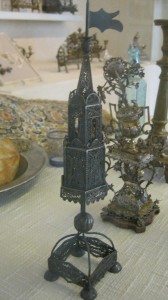
Silver filigree spice vessel at the Museum of Ethnography.
Now, however, being Jewish in Petersburg can be celebrated! I knew about the remodeled Grand Synagogue and about the establishment of a Jewish Studies Department at the University. But I realized how much pride is currently taken in being ethnically Jewish, at least by some people, when I went to the Russian Museum of Ethnography. As a child I had spent much time among its dusty and dark displays of costumes and strange attributes of exotic cultures of the world. Then I had never seen a Jewish display there. Now the exposition of the material culture of Jewish people in the territory of the Russian empire occupies the entire north side of the second floor in the left wing of the museum. It is designed according to the latest word of museology: there is a sitting area for watching film clips, there are interactive stations for finding information, and most importantly, there are numerous and well-displayed items such as household utensils, amulets, costumes, musical instruments, tools, calendars, illuminated manuscripts, and Torah scroll decorations from different Jewish diasporas, including such exotics as Bukharian and Dagestani Jews.
In this open and light-suffused space, with the delight of a discovery I studied the intricate silver work of spice vessels collected at the turn of the 20th century in the Pale of Settlement by Sholem An-sky, a prominent Russian-Jewish ethnographer, himself a feature of another exhibit at the museum. An-sky’s story has a special significance for me. I suspect that he was a model for a man by the last name of Tseitlin, whose collection of folktales I have been studying as part of my PhD research.
This ethnographer, whose first name is uncertain, was a Jewish political exile in the lands north of St. Petersburg. There, on the shores of the White Sea, in 1912, he recorded some of the most wonderful folktales from the poorest of the poor Russian peasant women. To a great extent, it was due to his efforts that the Russian North has come to be known as “the land of the female wonder tale.” Tseitlin was different from his fellow collectors in that he not only recorded stories but also took detailed, lyrical, and insightful notes devoted to each of his informants—a practice that became standard much later in ethnographic research. With great empathy he wrote about the women’s difficult life, and they seemed to respond warmly to him. For example, in his records, one older woman referred to him as “son.”
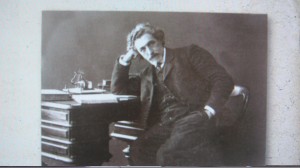
Photo of S. An-sky as he appears in the museum exhibit.
And so, at the museum, I studied photos of An-sky with great interest. Did Tseitlin look anything like that handsome dark researcher? I was alone in the hall, and I could take pictures or write down information without getting in anybody’s way. In the nearby Russian Museum, on that Sunday, throngs of tourists from all over Russia milled in front of the famous Jewish artist Isaak Levitan’s quintessential Russian landscapes. But at the Ethnography Museum exhibit, few people saw the treasures: a couple of German visitors, a father and a son (do I remember their wearing yarmulkes?), and two puzzled-looking Russian country women. This suggests to me that the ethnographic approach to Jewish life may not appeal either to Russians or to many Jews themselves. Jewish life in Russia seems to be beginning to mean religious life first of all, so that among Jews, the notion of Jewish identity may be shifting from referring to one’s ethnicity to being a practitioner of Judaism, in spite of an occasional reminder about one’s looks in the streets.
All photographs by the author.


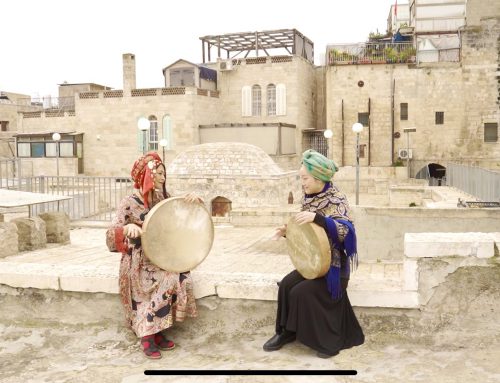
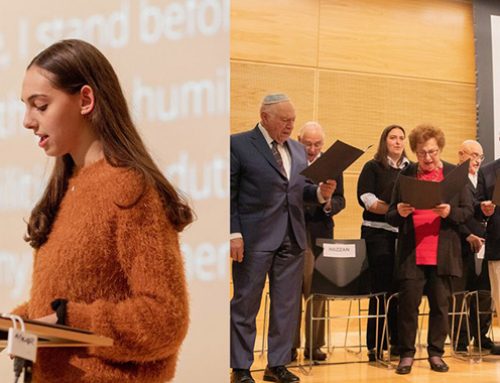

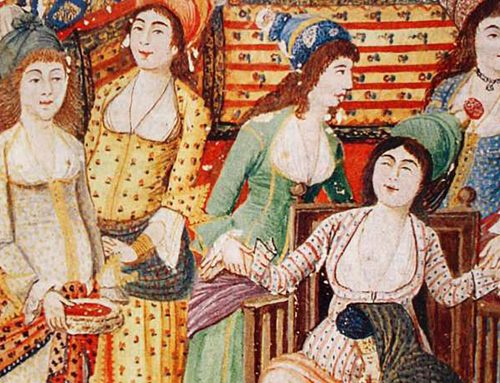
Leave A Comment